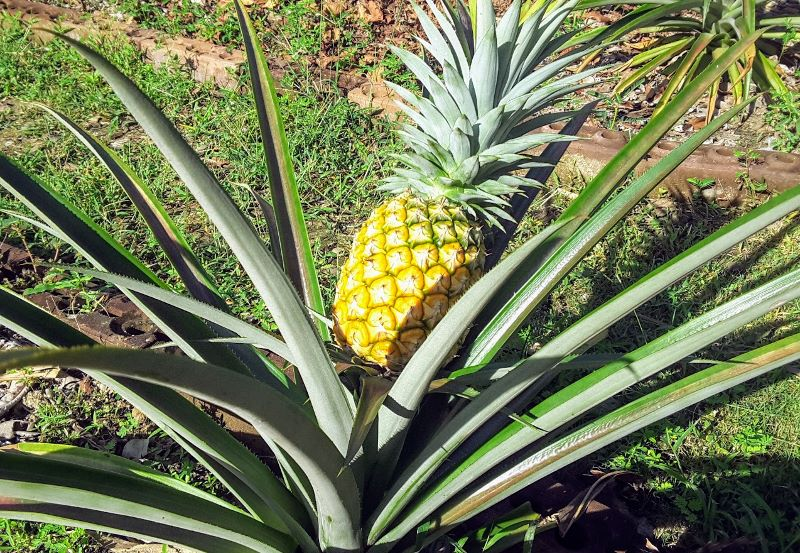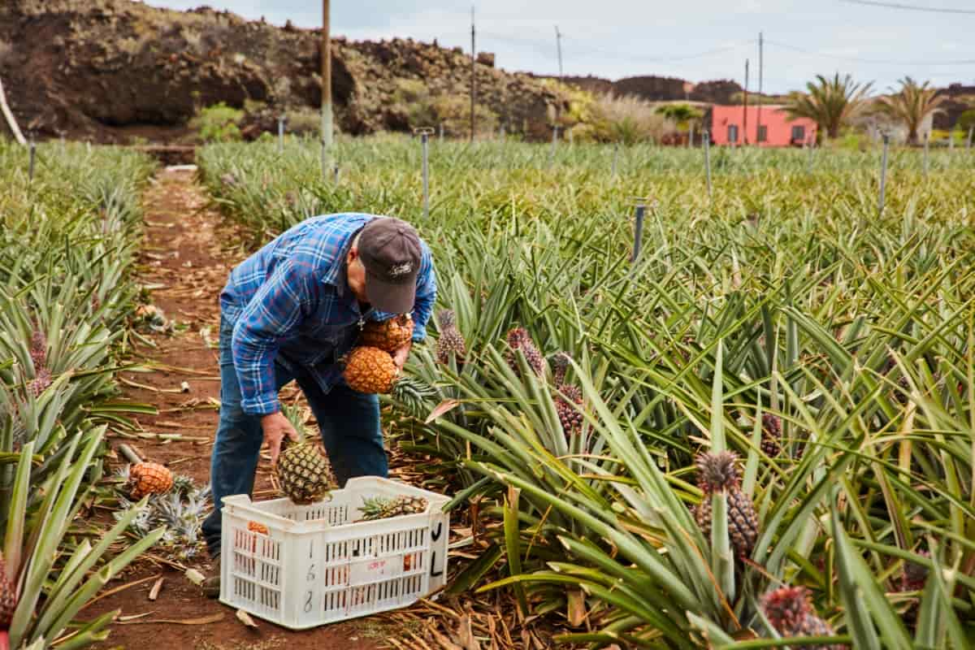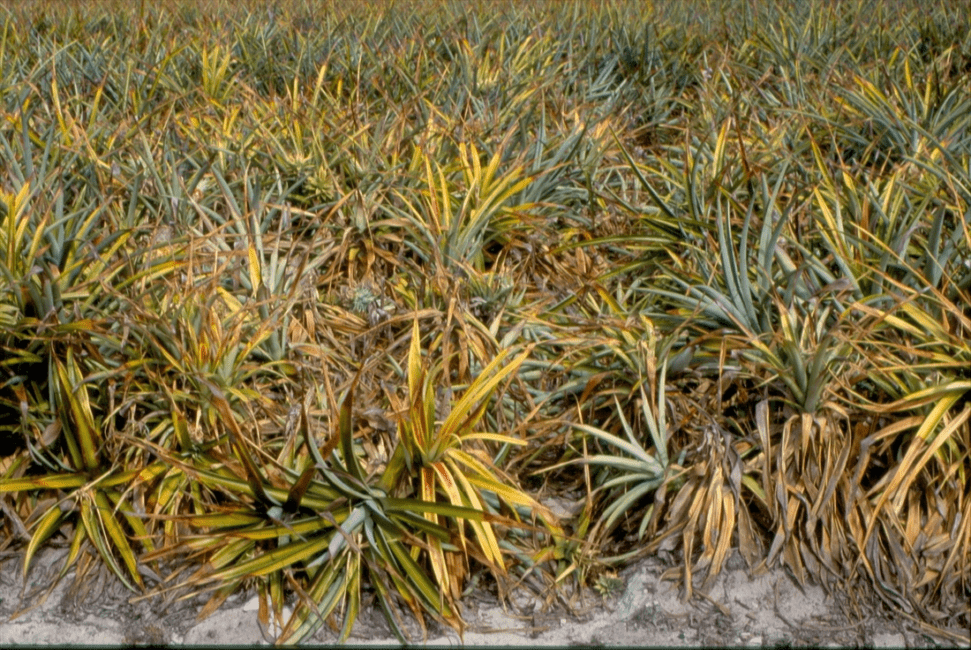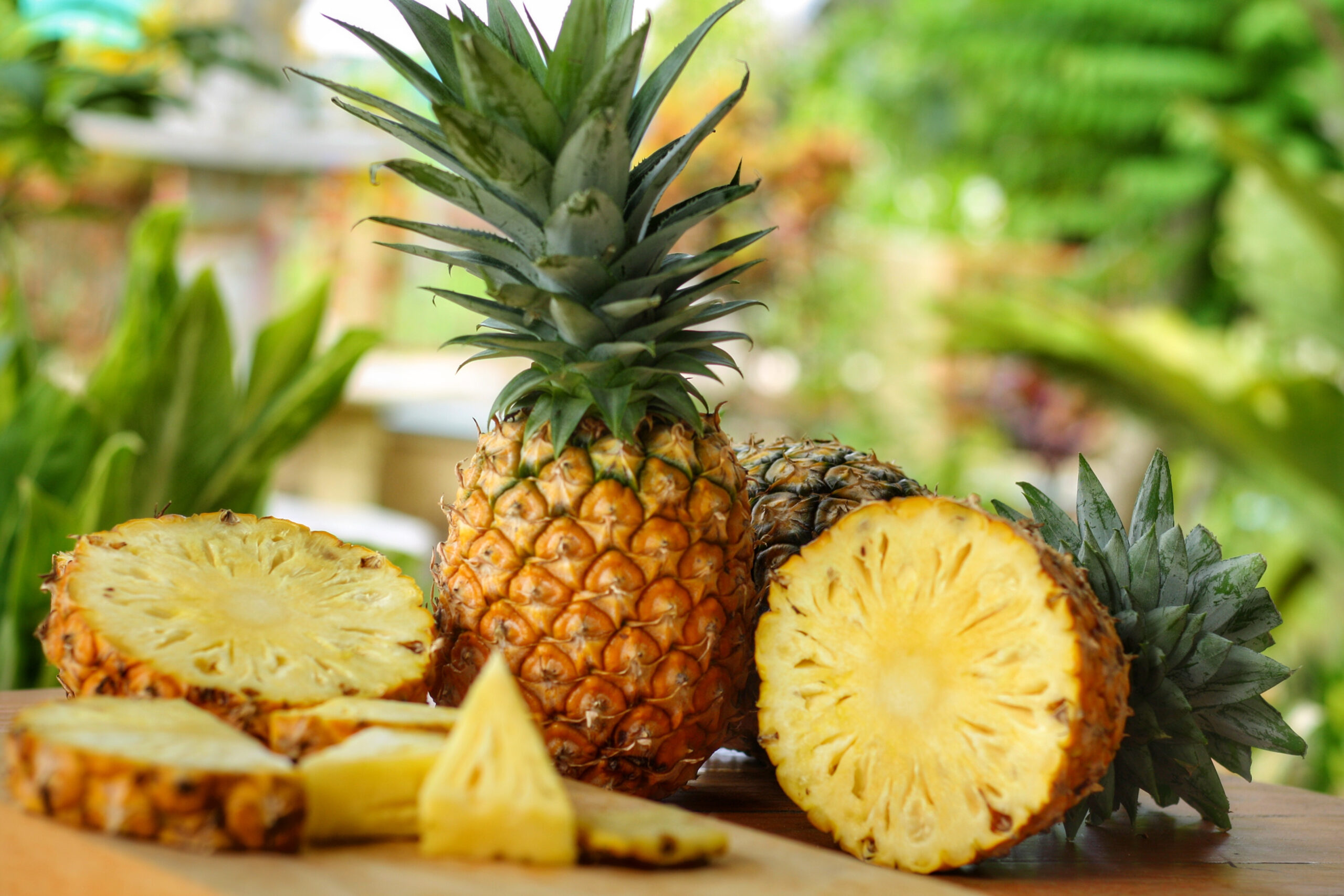Pineapple (Ananas comosus) belongs to the Bromeliaceae family and likely originated in South America. As global trade expanded, pineapple cultivation spread to other regions, and today it is grown in hot, wet, tropical areas, mainly near the equator. Four main varieties are used in industrial production: Cayenne, Singapore, Queen, and Red Spanish.
Australia and South Africa produce Queen; the Malaysian Peninsula grows Singapore; Red Spanish is cultivated in the Caribbean, while Cayenne is grown in Hawaii, Taiwan, the Philippines, and many other places.
In Nigeria, pineapples are commonly grown in the southern regions, often as a backyard crop or intercropped with yams, cassava, or cocoa. They are grown without special care or planting patterns, and are harvested when ripe. Pineapples thrive in areas with 1000mm or more of rainfall but do not grow well in swampy or waterlogged areas.
In regions with suitable soil and climate, small farms of 0.2-0.5 hectares can be found. The harvested fruits are sold to middlemen, who transport them to large urban areas and the northern parts of Nigeria for profit.
Uses
Pineapples are eaten as a dessert fruit throughout tropical and subtropical regions and are best when fully ripe. For shipping, half-ripe fruit can be transported at 7-10°C. Most of the commercial pineapple crop is canned in the producer countries.
The central part of the fruit, after removing the shell and core, is sliced, chunked, or diced. Crushed pineapple and canned juice can also be produced, and pineapple can be canned with other fruits in fruit salads.
Sugar syrup can be made from the mill juice, and alcohol and citric acid can also be produced. Fresh pineapple contains bromelain, a protein-digesting enzyme similar to papain from papaya, and can be used to make wine.
The leaves yield a strong white fiber used to make fine fabric. Pineapples also have some local medicinal uses, such as in Southeast Asia, where young fruits are used as an abortifacient. In Nigeria, a popular drink called soborodo is made with pineapple and roselle.
Read Also: How to Process, Package, and Export Pineapple
Origin and Distribution

The modern pineapple is believed to have been domesticated in South America, with its probable origin in Paraguay. Pineapples are now grown widely in tropical and subtropical regions. They have become an important economic crop in Malaysia, Hawaii, and other hot, wet tropical areas near the equator.
1. Cultivars
Many pineapple cultivars exist, but commercial production is mainly limited to four: Cayenne, Singapore, Queen, and Red Spanish. Cayenne is the most widely grown variety for commercial production and canning and is the basis for exports from Hawaii, the Philippines, Kenya, Mexico, and Taiwan.
It originated in Venezuela and was introduced to England around 1835, it was later taken to Hawaii, where it is now widely cultivated. Queen is an old variety grown mainly in Australia and South Africa for the fresh fruit trade.
It is said to have originated in Spain and was introduced to England in 1661 before spreading to Malaysia and Hawaii. Red Spanish is extensively cultivated in the West Indies, Cuba, Puerto Rico, and Mexico, mainly for the fresh fruit trade. Singapore is grown in Malaysia for the canning industry.
2. Ecology
Ananas comosus likely originated in a similar region, and most commercial pineapples are now grown at low elevations within 25°N and S. Pineapples cannot tolerate frost. In Hawaii, Cayenne is grown from sea level to 600m, with temperatures ranging from 32°C to 10°C. At higher elevations in Hawaii, Cayenne plants and fruits are smaller, with poorer color, flavor, and higher acidity.
Similar effects are seen in winter in Australia. In Kenya, where a canning factory has recently started, production is limited to altitudes of 1400-1800m, where Cayenne has a sugar-acid ratio of 16:1, ideal for canning.
Pineapples are drought-tolerant due to special storage cells and can grow with rainfall ranging from 635-2500mm per year, but the optimum for commercial production is 1000-1500mm.
Much commercial production is near the sea in areas with high humidity, where dew and other moisture collect in the leaf bases and are absorbed by the trichomes. Pineapples can be grown on a wide range of soils but do not tolerate waterlogging. Sandy loams with a pH of 5-6.5 are preferred.
3. Germination
Pineapple seeds can be produced through artificial cross-pollination, and they are harvested 5-6 months after pollination. The seeds are found about 1.7cm below the surface of the fruitlets and are obtained by cutting the fruits into longitudinal sections and removing the flesh around the core. The seeds are then washed and dried. Germination is slow and irregular unless treated with concentrated sulfuric acid for about one minute.
Seeds are sown on sterilized sand and kept at a temperature of about 32°C. They germinate in about 10 days, and after 30-40 days, the seedlings are transplanted into composted soil flats. They are then transplanted to the field after 15-18 months, with mature fruits produced in 16-30 months.
Chemical Composition
The edible portion of fresh pineapple, which constitutes about 60% of the fruit, contains approximately:
- Water: 85%.
- Protein: 0.4%.
- Sugar: 14%.
- Fat: 0.1%.
- Fiber: 0.5%.
Canned pineapple in syrup contains about:
- Water: 76%.
- Protein: 0.4%.
- Sugar: 22.6%.
- Acids (citric): 0.6%.
- Fiber: 0.4%.
Pineapple is a good source of vitamins A and B. The mill juice, from which sugar syrup and sometimes citric acid are obtained, contains 75-85% sugar and 7-9% citric acid on a dry weight basis. Pineapples also contain bromelain, a protein-digesting enzyme.
Propagation Methods
Pineapples are usually propagated vegetatively for practical purposes, except in breeding and research. Various materials are used for propagation:
1. Suckers: Arise from buds below ground level and are sparsely produced.
2. Shoots: Leafy branches that arise from buds in the leaf axils. Each plant produces up to three shoots, which are suitable for planting when 30-35cm long.
3. Slips: Borne on the peduncle just below or at the base of the fruit. They are smaller than shoots and are produced in varying numbers.
4. Harps: Shoots produced at the base of the peduncle, intermediate in size between shoots and slips.
5. Crown: Grows from the top of the fruit, with one crown produced except in Singapore Spanish, where the crown becomes dormant at maturity.
6. Butts or Stumps: Consist of the entire plant after the fruit has been harvested, used for propagation in Australia and South Africa.
These planting materials have considerable resistance to desiccation and can be stored for several weeks before planting.
Read Also: 10 Medicinal Health Benefits of Pineapple Weed (Matricaria discoidea)
Field Establishment and Management Methods

The typical crop cycle is four years from planting until the land is replanted. This includes one plant crop, one ratoon crop, and 6-9 months to prepare the land for the new crops. A second ratoon crop may be taken, requiring an additional year.
Land is cleared, and old plants are incorporated into the soil during replanting. Fields are plowed to a depth of 25-30cm, and the trash is left to rot. The soil may be fumigated to destroy nematodes and other destructive organisms.
Pineapples are usually planted at a density of 40,000 to 45,000 plants per hectare. They are planted in beds with two rows 60cm apart, 15cm from the edge, and 25-35cm apart in staggered rows. The distance between beds is 75-90cm. Weeding is necessary, especially during early growth, and can be done by hand, mechanically, or using selective herbicides.
1. Manuring
Heavy fertilizer application is required. Calcium ammonium nitrate should be applied at a rate of 112kg/ha before or 3 months after planting, with further applications at 3-6 month intervals, totalling 450-670kg during the cropping period. Potassium sulphate at 225-450kg/ha and ammonium phosphate at 170-280kg/ha should also be applied.
Iron deficiency causes leaf chlorosis, followed by reddish fruit color, which can be corrected with ferrous sulphate sprays. Zinc deficiency causes mottled yellow leaves and can be corrected with zinc sulphate sprays. Excess calcium and manganese lead to stunted plants.
2. Harvesting
Pineapples can be induced to flower and fruit before the normal time using ethylene, acetylene, or growth hormones such as NAA or its sodium salts. Hormones can also be used to bring ratoon plants into fruiting uniformly and at a predetermined date, and to force late-flowering plants to fruit with the rest of the crop.
Fruits are picked by hand, selecting only fully ripe ones. The yield per hectare is 38-75 tons for the plant crop, while the ratoon crop yields about half this amount.
3. Pests and Diseases
A Penicillium sp. can infect fruits during storage and transit, especially at temperatures below 10°C, resulting in softening of the fruitlets and a bitter taste. Ratooning with infected plants can result in much of the crop being lost.
Another disease, Phytophthora cinnamomi, causes root and heart rot, and can be controlled by applying metalaxyl or fosetyl-aluminum at planting. Another important disease, pineapple wilt, is transmitted by a mealy bug, and can be controlled by planting healthy plants.
Processing and Storage Methods
Pineapples are processed into a variety of products, most notably canned fruit, juice, and dehydrated slices. The main steps in the processing include peeling, coring, slicing, and canning in syrup. The fruit can also be crushed for juice or blended with other fruits for tropical fruit cocktails.
1. Canning: The majority of pineapples harvested for commercial purposes are canned. The process involves selecting ripe pineapples, removing the crown and skin, coring, slicing or crushing the fruit, and then packing it in syrup or juice. The cans are sealed and heat-treated to ensure preservation. This method allows pineapples to be stored for long periods and shipped globally.
2. Juice Production: Pineapple juice is popular both as a beverage and as an ingredient in mixed drinks. The juice is extracted from fresh fruit, filtered, pasteurized, and packaged. It may also be concentrated for export and later reconstituted by adding water. Pineapple juice contains bromelain, which can be used in meat tenderizers.
3. Dehydration: Dehydrated pineapple is produced by removing water content from the fruit. The process involves slicing the pineapple into rings or chunks and then drying it using air, freeze-drying, or vacuum-drying methods. Dehydrated pineapple is used as a snack, in baking, or as an ingredient in breakfast cereals.
4. Wine Production: Pineapple wine is another product that can be made by fermenting the juice. It is a popular alcoholic beverage in some regions.
5. Storage: Fresh pineapples are sensitive to storage conditions. They should be stored at a temperature of 7-10°C, which helps in slowing down the ripening process and prevents spoilage. However, storage below 7°C can cause chilling injury, leading to flesh browning and a bitter taste. For long-term storage, pineapples are typically canned, juiced, or dehydrated.
Economic Importance of Pineapple
Pineapple is a significant crop in many tropical and subtropical countries, providing employment and income for millions of people. Major pineapple-producing countries include Thailand, the Philippines, Costa Rica, India, and Indonesia. In these countries, the pineapple industry is an essential contributor to both the national economy and the livelihoods of smallholder farmers.
Pineapple production is often vertically integrated, with large multinational companies controlling much of the process from cultivation to processing and distribution. This has allowed for economies of scale, making pineapple products more affordable and widely available.
The global demand for pineapples and pineapple products continues to grow, driven by consumer preferences for healthy, tropical fruits, and the popularity of pineapple-flavored products such as juices, desserts, and beverages.
Challenges in Pineapple Cultivation

1. Pest and Disease Management: Pineapple cultivation faces challenges from pests and diseases, such as mealybugs, mites, and root rot caused by Phytophthora. Effective pest and disease management is crucial for maintaining high yields and quality.
2. Climate Change: Climate change poses a threat to pineapple cultivation, particularly in regions prone to extreme weather events, such as droughts, floods, and hurricanes. These events can disrupt production cycles, reduce yields, and damage crops.
3. Sustainability: Ensuring the sustainability of pineapple farming is another challenge. This includes the need to manage soil health, water resources, and biodiversity. Sustainable farming practices, such as intercropping, organic farming, and integrated pest management, are being promoted to address these challenges.
4. Market Access: Smallholder farmers often face difficulties in accessing markets due to limited infrastructure, lack of bargaining power, and competition from large multinational corporations. Efforts to improve market access, such as cooperative marketing, fair trade certification, and value addition, are essential for supporting smallholder farmers.
Future Prospects
The future of pineapple production looks promising, with increasing global demand for fresh and processed pineapples. Innovations in farming techniques, such as precision agriculture and biotechnology, offer the potential to improve yields, reduce input costs, and address challenges related to pests, diseases, and climate change.
The development of new pineapple varieties with improved disease resistance, better taste, and longer shelf life is also an area of active research. Furthermore, the expansion of organic pineapple production caters to the growing consumer demand for organic and sustainably produced foods.
In conclusion, pineapple remains a vital crop with significant economic, social, and cultural importance. Continued investment in research, technology, and sustainable practices will be essential to ensure the long-term viability and success of the pineapple industry.
Read Also: Complete List of High Fiber Foods you Should Know About
Frequently Asked Questions
We will update this section soon.

